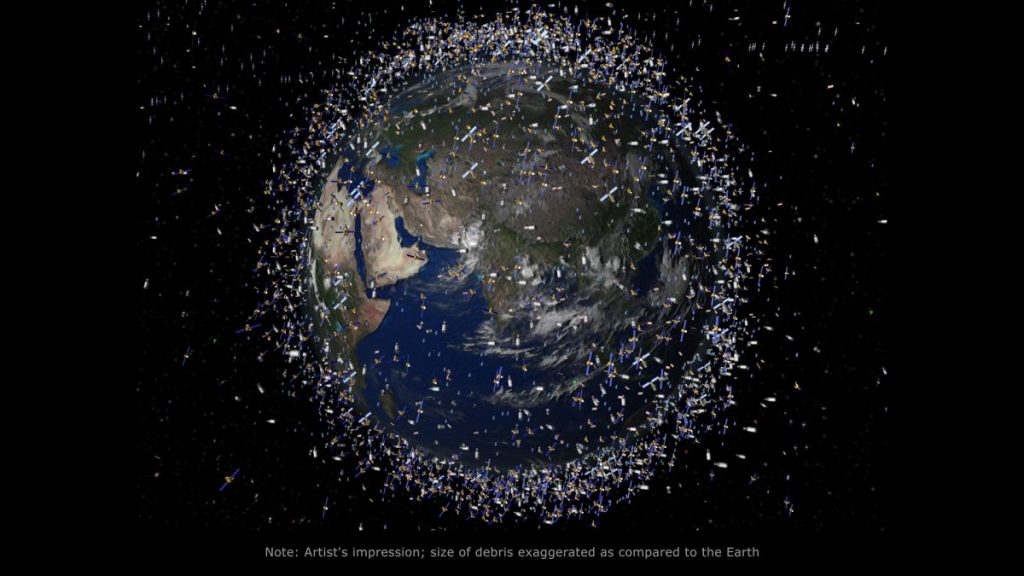Changes in Earth’s atmosphere resulting from climate change are working against efforts to clean dangerous debris out of orbit around Earth.
According to a new study by the British Antarctic Survey, increasing levels of carbon dioxide reduce the density of the upper atmosphere, meaning that objects orbiting close to Earth face less drag and stay afloat longer.
That may be good news for satellite operators, who have lately seen their satellites dropping down faster than ever because of worsening space weather. On the other hand, defunct satellites and space debris objects that are slowly making their way down through the atmosphere will keep cluttering their orbits longer. And that means a higher risk of dangerous collisions that could generate massive amounts of dangerous debris fragments.
The worrying changes in atmospheric density will be measurable at altitudes between 56 and 310 miles (90 and 500 kilometers), the British Antarctic Survey said in a statement, and will occur even under moderate greenhouse gas emission scenarios that have been predicted.
Related: Satellites can disappear in major solar storms and it could take weeks to find them
Ingrid Cnossen, a research fellow at the British Antarctic Survey, made those conclusions based on computer models of the entire atmosphere. She analyzed the last 50 years of the atmosphere’s evolution and compared that with projections based on future emission scenarios. The model, which looked 50 years into the future based on predictive models, revealed twice as significant thinning of Earth’s upper atmosphere compared to the past 50 years.
“Changes we saw between the climate in the upper atmosphere over the last 50 years and our predictions for the next 50 are a result of carbon dioxide emissions,” Cnossen said in the statement. “It is increasingly important to understand and predict how climate change will impact these regions, particularly for the satellite industry and the policymakers who are involved with setting standards for that industry.”
The thinning of the upper atmosphere has to do with the cooling caused by greenhouse gas, a paradoxical effect that goes against what scientists see happening closer to Earth.
NASA’s Earth observing satellites previously measured this effect (opens in new tab), which scientists say is caused by the sparse distribution of air molecules in the upper atmosphere compared to the layers closer to the planet’s surface. In the lower atmosphere, molecules are packed tightly together and trap the heat that carbon dioxide absorbs. In the upper atmosphere, the carbon dioxide molecules still absorb heat, but since there are not many molecules around to share the heat with, it soon gets radiated away into outer space. As the upper atmosphere emits heat, it cools down and shrinks. And where it shrinks, space objects suddenly have a smoother ride, extending their orbital lifetime. Experts worry that this drag reduction can worsen the space debris problem that has concerned the space community for quite a few years now.
“Space debris is becoming a rapidly growing problem for satellite operators due to the risk of collisions, which the long-term decline in upper atmosphere density is making even worse,” Cnossen said. “I hope this work will help to guide appropriate action to control the space pollution problem and ensure that the upper atmosphere remains a usable resource into the future.”
The U.S. Global Surveillance Network currently tracks some 30,000 pieces of debris in Earth orbit larger than 4 inches (10 centimeters). On top of that, about a million 0.4-inch-wide (1 cm) fragments hurtle around the planet, according to the European Space Agency (opens in new tab). The situation is bound to get worse as the number of satellites in near-Earth space quickly rises with the deployment of new constellations. With the increase of defunct objects in orbit, the danger of collisions also rises, leading to a domino effect. Such collisions could create thousands more fragments, which would then threaten other spacecraft, and so on
Some experts worry that we may already be witnessing the beginning of a phenomenon known as the Kessler Syndrome, an unstoppable cascade of collisions that could render the space around Earth completely unusable.
Space agencies as well as private companies are looking at means of removing debris from low Earth orbit, the region below 600 miles (1000 km), with the help of technology. Still, they need the atmosphere’s help to keep things in check. It now seems climate change might be working against them.
The study (opens in new tab) was published in the journal Geophysical Research Letters in September.
Follow Tereza Pultarova on Twitter @TerezaPultarova (opens in new tab). Follow us on Twitter @Spacedotcom (opens in new tab) and on Facebook (opens in new tab).

